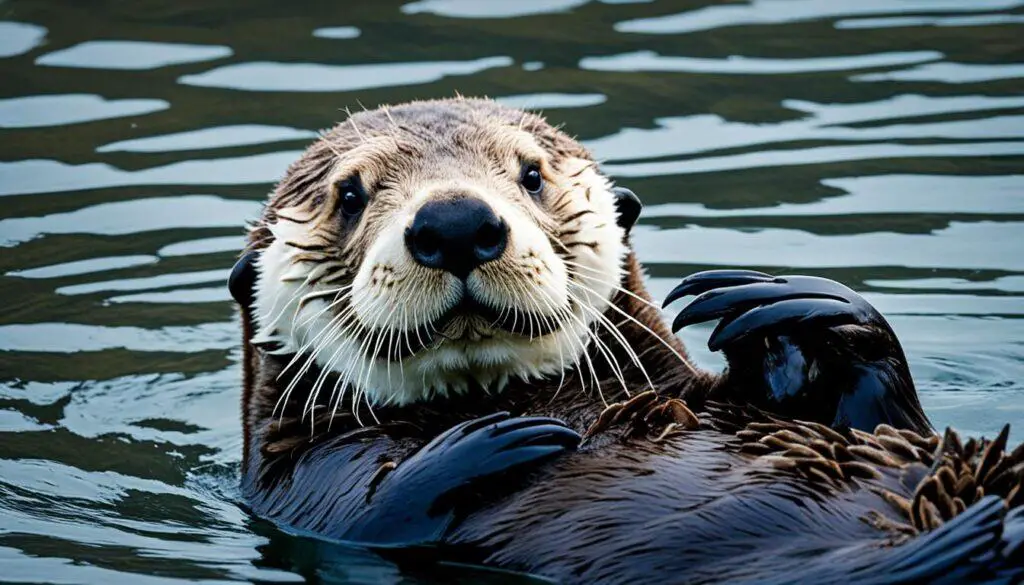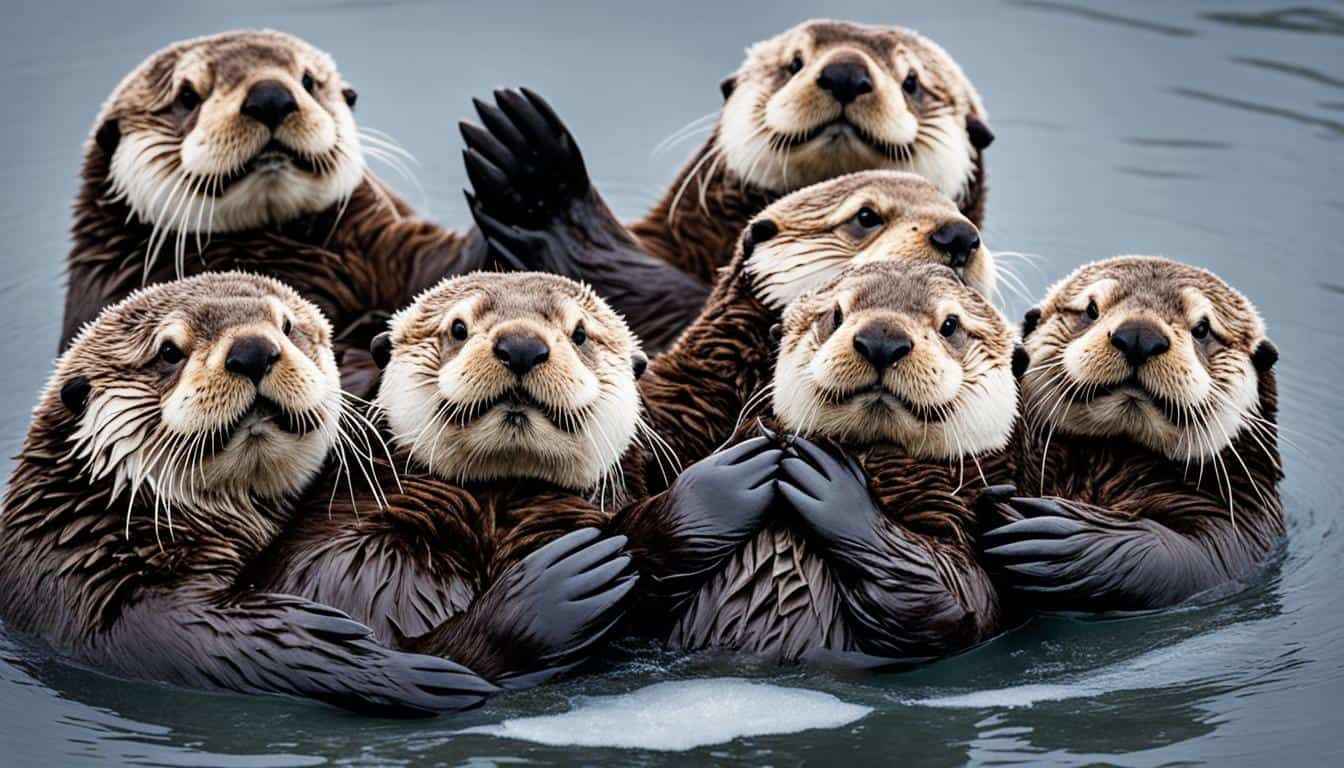Sea otters are amazing creatures that live in cold water. They are experts at staying warm in these chilly environments. But how do they do it? Their thick fur helps a lot, but they have more tricks up their sleeves.
Sea otters have the thickest fur of any mammal, which keeps them cozy. But it’s not just their fur that helps them stay warm. They also have a high metabolism and special ways to make heat. These strategies let them survive in very cold places.
Introduction to Sea Otters and Their Cold Habitat
Sea otters live in the cold waters of the Northern Pacific Ocean. They are small but tough creatures that have learned to survive in the cold. Their ways of staying warm are amazing and show how they’ve adapted over time.
Understanding the Environment
The cold water makes it hard for sea otters to stay warm. Water takes heat away from the body faster than air does. So, they need to keep warm to survive.
Sea otters don’t have the thick blubber that bigger marine animals have. But they’re not at a loss. Their fur is incredibly thick, with up to a million hairs per square inch. This fur keeps air close to their skin, keeping them warm.
Sea otters live in a tough environment under the sea. They’ve changed their behavior and body to live in the cold. They’ve found ways to thrive in conditions that would be hard for many other animals.
How do sea otters keep warm in cold water?
Sea otters live in very cold oceans and have special ways to stay warm. They have biological features that help them in the cold. Let’s look at how their body traits help them stay warm.
Sea otters have a much faster metabolism than animals of similar size. Their metabolism is about three times faster, which helps them stay warm. This high energy use is key in cold water where they lose heat quickly.
To keep up with their high energy needs, sea otters eat a lot. They eat about 25% of their body weight every day. They mainly eat sea urchins, crabs, and fish. This helps them get the calories they need to stay warm.
By eating a lot and having a fast metabolism, sea otters can live in cold water. Their special ways of adapting show how nature solves tough problems.

The Importance of Insulation in Sea Otters
Sea otters can survive in cold ocean waters thanks to their amazing insulation. Their thick fur coat keeps them warm in freezing temperatures. This fur is key to their survival.
The Role of Dense Fur
Sea otters have the thickest fur of any marine mammal, with up to a million hairs per square inch. This fur not only keeps them warm but also traps air, keeping them stable in temperature. This insulation is crucial for their survival, keeping them from losing heat in the cold.
Every hair in their fur helps keep the heat in. This shows how nature has equipped them for their cold home.
Maintenance of Fur for Optimal Insulation
Sea otters spend about 10% of their day cleaning their fur. This keeps their fur fluffy and free of dirt. It helps their fur trap air better, keeping them warm.
If they don’t groom, their fur won’t insulate well. This makes them more likely to get cold. So, grooming is very important for them.
| Feature | Description |
|---|---|
| Fur Density | Up to 1 million hair strands per square inch |
| Body Heat Retention | Traps air, improving thermal stability |
| Grooming Time | About 10% of daily activity |
| Impact of Neglect | Reduces insulating properties, increases cold vulnerability |
Metabolic Adaptations for Heat Production
Sea otters live in freezing marine environments. They have special ways to make heat. Their high metabolic rate helps them stay warm in cold waters.
High Metabolic Rates
Sea otters have some of the highest metabolic rates among mammals. This is key to their survival in cold places. When they eat, they turn food into energy efficiently. This process makes a lot of heat, helping them stay warm.
This is important because they don’t get warm by swimming or shivering much.
Leak Respiration Mechanism
The leak respiration mechanism is crucial for sea otters. It means they lose some energy as heat when making ATP. This happens even in baby sea otters, showing it’s vital for their survival.
This special way of making heat lets sea otters live in cold water. It shows how well they are adapted to their marine life.
FAQ
How do sea otters keep warm in cold water?
Sea otters stay warm in cold water thanks to their thick fur and fast metabolism. Their fur traps air, keeping them insulated. Their metabolism also helps produce heat, keeping their body temperature stable in cold water.
Why is insulation important for sea otters?
Insulation is key for sea otters because water takes heat away quickly. Their fur, made up of millions of hairs, traps air. This air acts as a thermal barrier against the cold.
How does sea otter grooming contribute to their warmth?
Grooming is crucial for sea otters to keep their fur effective at insulating them. They spend about 10% of their day cleaning their fur. This keeps it free of water and debris, helping to keep the air trapped for warmth.
What role does food play in keeping sea otters warm?
Food is essential for sea otters because they need to eat a lot to stay warm. They eat over 20% of their body weight daily. This food gives them the energy to produce heat, keeping them warm in cold water.
What is leak respiration in sea otters?
Leak respiration is a process that helps sea otters lose energy as heat when they turn nutrients into ATP. This process helps them stay warm. It lets them survive in cold water without just relying on activity or shivering.
Do newborn sea otters have adaptations for warmth?
Yes, newborn sea otters have adaptations for warmth just like adults. They have high metabolic rates and can make heat through muscle metabolism. These traits are crucial for their survival in cold water from the start.
Source Links
- https://research.tamu.edu/2021/07/21/how-do-sea-otters-live-in-cold-water-excess-energy-keeps-them-warm/
- https://www.snexplores.org/article/heres-how-sea-otters-stay-warm-without-blubber-or-a-large-body
- https://www.sciencealert.com/scientists-found-the-real-way-sea-otters-stay-warm-in-cold-waters-leaky-skeletal-muscle







